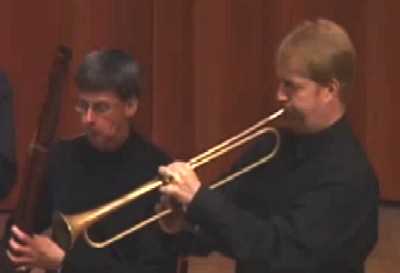
W e have heard these popular concertos many times, though never with as much clarity or joie de vivre as the Academy of Ancient Music's expert, one-to-a-part reading, where every line and timbre is as distinct and perfectly balanced as it must have been in the composer's imagination.”T he Academy of Ancient Music’s gave a phenomenal performance of the Brandenburg Concertos last night in Kansas City, one of the stops on their U.S. tour. Richard Egarr, the group’s current director, has won enthusiastic praise from critics and audiences. The sold-out audience in K.C. surely agreed.
— Elissa Poole, The Globe and Mail (Toronto), commenting on AAM’s just-released recording of the Brandenburges on Harmonia Mundi.
T he inscription of 24-MAR-1721 on the dedication manuscript to Chistian Ludwig, the Margrave of Brandenburg-Schwedt, is the nominal date of composition. But most likely the Brandenburgs had been written earlier, over the span of Bach’s service as Kapellmeister at Köthen. Some think they are even earlier, maybe 1708 to 1715—when Bach was in his 20s. These are, as Egarr told us last night, “really youthful pieces”, composed in the midst of ‘Vivaldi Fever’.

T he one that intrigued me most last night was the #6: Concerto 6to à due Viole da Braccio, due Viole da Gamba, Violoncello, Violone e Cembalo (Allegro; Adagio ma non troppo; Allegro), scored for two violas da braccio, two violas da gamba, cello, violone, and harpsichord.
T he lack of violins is itself unusual. Viola da braccio is specifically a ‘modern’ viola, not the older viola da gamba. And the #6 is thought to be the oldest one—the one Bach composed when he was the youngest.
O ther theories hold that, since the viola da braccio was typically played by servants or others of lower social standing (‘pick-up’ ensembles), Bach’s intent was a political/desultory one—to thumb his nose at the musical establishment by giving a lead part to a then-supposedly inferior instrument and its players. He wanted to piss-off Prince Leopold? He was trying to get himself ‘fired’?
T he two violas start the first movement with parts in close canon. Then we get developments where the parts are seduced into melodic inventions. The two violas da gamba keep quiet in the second movement, creating a back-handed quasi-trio sonata for the two violas and continuo. “Young whipper-snappers.”
I n the third movement of the No. 6, the spirit of the gigue underlies everything, but it’s not motoric and ebullient like other of the concertos.
T he texture of the No. 6 is dark, especially in the first two movements. Surprisingly dark, despite the ‘one-instrument-per-part’ orchestration that AAM maintains—and the openness of the articulation that is associated with this orchestration.
B -flat major, yes, but the timbre has a ‘twenty-something’ darkness/brooding/melancholiness about it—yet without petulance or moroseness or narcissism.
N ice to see the whipper-snapper violas switching back and forth and swapping parts in the No. 6. We can’t hear that exchange on recordings—especially ones where the violas maintain nearly identical tone and bowing style—but with AAM the visual effect on-stage is amusing. It’s like some Noel Coward farce—the rapscallious violas getting away with a trick—obfuscating their identities; each one taking turns masquerading/impersonating the other.
- Bach - Brandenburg Concertos
- Concerto No. 1 in F major, BWV 1046a
- Concerto No. 6 in B-flat major, BWV 1051
- Concerto No. 2 in F major, BWV 1047
- Concerto No. 5 in D major, BWV 1050a
- Concerto No. 3 in G major, BWV 1048
- Concerto No. 4 in G major, BWV 1049

- Academy of Ancient Music website
- Richard Egarr on MySpace
- Bach Brandenburgs scores at IMSLP
- Notes on Brandenburgs at ClassicalNotes.net
- Notes on Brandenburgs at Inkpot.com
- BaroqueTrumpet.com
- David Blackadder at Birmingham Conservatoire
- Richard Egarr & Academy of Ancient Music. Bach Brandenburg Concertos 1 - 6. (Harmonia Mundi, 2009.)
- Boyd M. Bach: The Brandenburg Concertos. Cambridge Univ, 1993.
- Marissen M. The Social and Religious Designs of J. S. Bach's Brandenburg Concertos. Princeton, 1999.
- Wolff C. Johann Sebastian Bach: The Learned Musician. Norton, 2001.
No comments:
Post a Comment